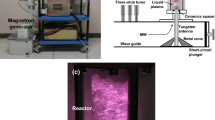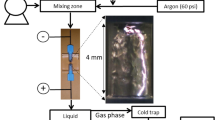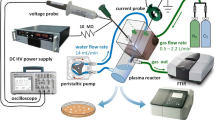Abstract
The effects of changes in the mode of delivery of nanosecond pulses in a gas–liquid plasma reactor on the formation of hydrogen peroxide, H2O2, and, as an indicator for ·OH radicals, the decoloration of methylene blue, MB, were determined for pulse delivery by (a) increasing frequency with uniform pulses (5–50 kHz), (b) variation of the time between bursts of pulses (burst period), (c) changing the inner burst frequency (1 over the time between the pulses in the burst), and (d) variation of number of pulses in a burst (N-cycles). H2O2 peroxide formation was not affected by the method of pulse delivery in the range of parameters studied here and all data followed an approximately linear increase in H2O2 production rate with discharge power. In contrast, the MB decoloration rate was affected by the burst modes. In terms of discharge power, the MB decoloration rate was highest for the uniform pulse mode; however, the linear trend in increase of MB decoloration with power when the burst period was varied, suggest that at higher power the burst mode may be more effective than the uniform pulsing. Consideration of the per pulse decoloration with energy per pulse and with number of pulses suggest that the burst mode can affect reactions differently from applying a uniform pulse.














Similar content being viewed by others
References
Bruggeman PJ, Kushner MJ, Locke BR, Gardeniers JGE, Graham WG, Graves DB, Hofman-Caris RCHM, Maric D, Reid JP, Ceriani E, Rivas DF, Foster JE, Garrick SC, Gorbanev Y, Hamaguchi S, Iza F, Jablonowski H, Klimova E, Kolb J, Krcma F, Lukes P, Machala Z, Marinov I, Mariotti D, Thagard SM, Minakata D, Neyts EC, Pawlat J, Petrovic ZL, Pflieger R, Reuter S, Schram DC, Schroter S, Shiraiwa M, Tarabova B, Tsai PA, Verlet JRR, von Woedtke T, Wilson KR, Yasui K, Zvereva G (2016) Plasma-liquid interactions: a review and roadmap. Plasma Sources Sci Technol 25(5):053002
Brandenburg R, Bogaerts A, Bongers W, Fridman A, Fridman G, Locke BR, Miller V, Reuter S, Schiorlin M, Verreycken T, Ostrikov K (2019) White paper on the future of plasma science in environment, for gas conversion and agriculture. Plasma Processes Polym 16(1):e1700238
Weltmann K-D, Kolb JF, Holub M, Uhrlandt D, Simek M, Ostrikov K, Hamaguchi S, Cvelbar U, Cernak M, Locke B, Fridman A, Favia P, Becker K (2019) The future for plasma science and technology. Plasma Processes Polym 16(1):e1800118
Locke BR, Shih K-Y (2011) Review of the methods to form hydrogen peroxide in electrical discharge plasma with liquid water. Plasma Sources Sci Technol 20(3):034006
Patil BS, Wang Q, Hessel V, Lang J (2015) Plasma N-2-fixation: 1900–2014. Catal Today 256:49–66
Thanh PN, Sugai T, Tokuchi A, Jiang WH (2022) The effect of pulse discharge control on ozone production. IEEE Trans Plasma Sci 50(4):936–941
Kruger F, Lee H, Nam SK, Kushner MJ (2021) Electric field reversals resulting from voltage waveform tailoring in Ar/O-2 capacitively coupled plasmas sustained in asymmetric systems. Plasma Sources Sci Technol 30(8).
Zhu YF, Bo Y, Chen XC, Wu Y (2022) Tailoring electric field signals of nonequilibrium discharges by the deep learning method and physical corrections. Plasma Process Polymers 19(3).
Thanh PN, Sugai T, Tokuchi A, Jiang WH. The influence of pulse shape on the production of OH radicals by pulsed discharge. IEEE Trans Plasma Sci 5(1):199–204
Pourali N, Hessel V, Rebrov EV (2022) The effects of pulse shape on the selectivity and production rate in non-oxidative coupling of methane by a Micro-DBD reactor. Plasma Chem Plasma Process 42(3):619–640
Szulc M, Forster G, Marques-Lopez JL, Schein J (2022) Influence of pulse amplitude and frequency on plasma properties of a pulsed low-current high-voltage discharge operated at atmospheric pressure. Appl Sci-Basel 12(3).
Thana P, Kuensaen C, Poramapijitwat P, Sarapirom S, Yu LD, Boonyawan D (2020) A compact pulse-modulation air plasma jet for the inactivation of chronic wound bacteria: Bactericidal effects & host safety. Surface Coatings Technol, 400.
Shen SK, Yan JQ, Wang YA, Wang YS, Ding WD, Sun GX (2022) Stepwise development of atmospheric pressure plasma jet driven by bursts of high-voltage nanosecond pulses at multi-tens MHz. Plasma Sources Sci Technol 31(10).
Huang BD, Zhang C, Sun H, Sorokin DA, Tarasenko VF, Shao T (2022) Enhancement of hydrogen radical density in atmospheric pressure plasma jet by a burst of nanosecond pulses at 1 MHz. Plasma Sources Sci Technol 31(2).
Gromov M, Leonova K, Britun N, De Geyter N, Morent R, Snyders R, Nikiforov A (2022) Plasma nitrogen fixation in the presence of a liquid interface: role of OH radicals. Reaction Chem Eng 7(5):1047–1052
Wandell RJ, Locke BR (2014) Low-power pulsed plasma discharge in a water film reactor. IEEE Trans Plasma Sci 42(10):2634–2635
Wandell RJ, Wang H, Tachibana K, Makled B, Locke BR (2018) Nanosecond pulsed plasma discharge over a flowing water film: Characterization of hydrodynamics, electrical, and plasma properties and their effect on hydrogen peroxide generation. Plasma Processes Polymers 15(6).
Wang HH, Wandell RJ, Locke BR (2018) The influence of carrier gas on plasma properties and hydrogen peroxide production in a nanosecond pulsed plasma discharge generated in a water-film plasma reactor. J Phys D-Appl Phys 51(9):13
Wang H, Wandell RJ, Tachibana K, Vorac J, Locke BR (2019) The influence of liquid conductivity on electrical breakdown and hydrogen peroxide production in a nanosecond pulsed plasma discharge generated in a water-film plasma reactor. J Phys D-Appl Phys 52(7):075201.
Bresch S, Wandell R, Wang H, Alabugin I, Locke BR (2016) Oxidized derivatives of n-hexane from a water/argon continuous flow electrical discharge plasma reactor. Plasma Chem Plasma Process 36(2):553–584
Hsieh K, Wang HJ, Locke BR (2016) Analysis of a gas-liquid film plasma reactor for organic compound oxidation. J Hazard Mater 317:188–197
Xiong Y, Zhang Q, Wandell R, Bresch S, Wang H, Locke BR, Tang Y (2019) Synergistic 1,4-dioxane removal by non- thermal plasma followed by biodegradation. Chem Eng J 361:519–527.
Wandell RJ, Wang H, Bulusu RKM, Gallan RO, Locke BR (2019) Formation of nitrogen oxides by nanosecond pulsed plasma discharges in gas-liquid reactors. Plasma Chem Plasma Process 39(3):643–666
Bulusu RKM, Wandell RJ, Gallan RO, Locke BR (2019) Nitric oxide scavenging of hydroxyl radicals in a nanosecond pulsed plasma discharge gas liquid reactor. J Phys D-Appl Phys 52(50).
Hsieh KC, Wandell RJ, Bresch S, Locke BR (2017) Analysis of hydroxyl radical formation in a gas-liquid electrical discharge plasma reactor utilizing liquid and gaseous radical scavengers. Plasma Processes Polym 14(8):e1600171
Bulusu RK, Wandell RJ, Zhang Z, Farahani M, Tang Y, Locke BR (2020) Degradation of PFOA with a nanosecond-pulsed plasma gas-liquid flowing film reactor. Plasma Processes Polym 17(8):2000074
Bulusu RKM, Yatom S, Patterson CW, Wandell RJ, Locke BR (2022) Effects of frequency and pulse width on electron density, hydrogen peroxide generation, and perfluorooctanoic acid mineralization in a nanosecond pulsed discharge gas-liquid plasma reactor. J Vac Sci Technol A Vac Surf Films 40(6):063001
Wandell RJ, Bresch S, Wang H, Babicky V, Lukes P, Locke BR (2020) The effects of pulse frequency on chemical species formation in a nanosecond pulsed plasma gas-liquid film reactor. Int J Plasma Environ Sci Technol 14(e01008):1–9.
Vinson E, Bulusu R, Wandell R, Locke B (2022) Chemical reduction by aqueous electrons in a nanosecond pulsed discharge gas-liquid plasma reactor. Int J Plasma Environ Sci Technol 16(2):e02005 (15 pp).
Reddy PMK, Raju BR, Karuppiah J, Reddy EL, Subrahmanyam C (2013) Degradation and mineralization of methylene blue by dielectric barrier discharge non-thermal plasma reactor. Chem Eng J 217:41–47
Eisenberg GM (1943) Colorimetric determination of hydrogen peroxide. Ind Eng Chem Anal Ed 15(5):327–328
Tao S, Guangsheng S, Ping Y, Jue W, Weiqun Y, Yaohong S, Shichang Z (2006) An experimental investigation of repetitive nanosecond-pulse breakdown in air. J Phys D Appl Phys 39(10):2192
Hsieh KC, Wandell RJ, Bresch S, Locke BR (2017) Analysis of hydroxyl radical formation in a gas-liquid electrical discharge plasma reactor utilizing liquid and gaseous radical scavengers. Plasma Processes Polym 14(8):14
O’Sullivan DW, Lee M, Noone BC, Heikes BG (1996) Henry’s law constant determinations for hydrogen peroxide, methyl hydroperoxide, hydroxymethyl hydroperoxide, ethyl hydroperoxide, and peroxyacetic acid. J Phys Chem 100(8):3241–3247
Arangio AM, Slade JH, Berkemeier T, Pöschl U, Knopf DA, Shiraiwa M (2015) Multiphase chemical kinetics of OH radical uptake by molecular organic markers of biomass burning aerosols: humidity and temperature dependence, surface reaction, and bulk diffusion. J Phys Chem A 119(19):4533–4544
Funding
Partial support from the U.S. Department of Energy, Office of Science, Office of Basic Energy Sciences, under Award No. DE-SC-0021371. Additional support from Florida State University, Department of Chemical and Biomedical Engineering at the FAMU-FSU College of Engineering is appreciated.
Author information
Authors and Affiliations
Contributions
RKMB—Postdoctoral Associate—conducted experiments on H2O2, methylene blue, analyzed data, made graphs, supervised other student performing methylene blue and hydrogen peroxide experiments, helped in writing the manuscript and interpreting the data. Wrote the methods section and helped edit the other sections. NM—Undergraduate researcher—conducted experiments on methylene blue. CP—MS student—conducted experiments on H2O2. RJW—faculty member—helped conceive idea for project, helped supervise and provided guidance to laboratory work and helped to interpret and analyze data. BRL—Project PI—Directed all work, obtained university support, supervised work, wrote main body of text with assistance from Radha Bulusu, analyzed data and worked with RB in editing manuscript and interpreting results.
Corresponding author
Ethics declarations
Conflict of interest
Professor Bruce R. Locke is an editor-in-chief of Plasma Chemistry and Plasma Processing.
Ethical Approval
Not applicable.
Additional information
Publisher's Note
Springer Nature remains neutral with regard to jurisdictional claims in published maps and institutional affiliations.
Supplementary Information
Below is the link to the electronic supplementary material.
Rights and permissions
Springer Nature or its licensor (e.g. a society or other partner) holds exclusive rights to this article under a publishing agreement with the author(s) or other rightsholder(s); author self-archiving of the accepted manuscript version of this article is solely governed by the terms of such publishing agreement and applicable law.
About this article
Cite this article
Bulusu, R.K.M., Mihajlov, N., Patterson, C.W. et al. Gas–Liquid Chemical Reactions with Nanosecond Pulses: Role of Frequency and Pulse Delivery Modes. Plasma Chem Plasma Process 43, 1549–1565 (2023). https://doi.org/10.1007/s11090-023-10420-0
Received:
Accepted:
Published:
Issue Date:
DOI: https://doi.org/10.1007/s11090-023-10420-0




